mjotrainbrain
Registered
It's hard to express concisely how excited I am to be finally building my own garden railway, but I'm sure many of you can understand! This is something that I've wanted to do about as long as I can remember, and the opportunity has finally come along. Last week I purchased what is more or less an REA starter set off Facebook Marketplace. It consists of a 2-4-2 Rogers locomotive with slopeback tender in B&O paint. It's got a couple rough edges from years of use, but overall it seems solid. The speaker in the tender seems to be blown, some parts are broken on the locomotive which I should be able to repair, and the paint has some scratches. I also have not yet tested if the smoking function works. Would Lionel smoke fluid be OK to use? I have a lot of that kicking around. I also got a pair of REA passenger cars (1x coach and 1x combine; not the deluxe version unfortunately) which need the 3 of the 8 steps glued back on, an REA model 5400 power pack, 24x REA 4' diameter curves, 6x REA 3' straights, and 1x LGB 2' straight track piece. To me, this is a perfect amount of equipment to get a layout built in the space I have, although I'm sure one or two turnouts will be added before long.
The first thing for me was to test what does and doesn't work, and then clean it all up. I was initially disappointed that the loco did not run despite being advertised as working, however after a thorough reading of the instructions my dad noticed a switch that had to be flipped in the cab. Doh! Dining table pic showing off my freshly dusted Rogers:
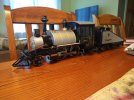
Next up I restrained my excitement to start laying track long enough to clean all the rail joiners in vinegar and salt, and used my automotive wiring skills and supplies to make a nice waterproof track power lead. This way I can unplug the transformer and leave the wires connected to the track behind, with zero concerns of moisture or creepy-crawlies settling inside the connector. At this point I found something to gripe about; the tiny screws holding the ties to the rails. They're fine for that, but once you try to get ring terminals attached to provide track power they're barely long enough and its hard to find ring terminals small enough. It's a small issue though, and eventually I intend to get power to the tracks through rail clamps anyhow.
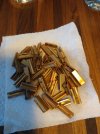
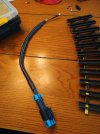
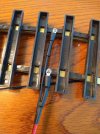
Next up, I had to select a place to begin construction. Being a uni student who still lives at home, that was a decision that had to be made with my mom. We found a suitable place where the dog couldn't do any damage (she's a black lab who LOVES to dig holes) and where the train would be a nice decoration. The space measures about 6' x 13' with a very slight grade from front to back. Here is some very initial planning:
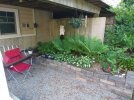
It quickly became clear that this spot was way too plant-dense. Luckily there were other places they could be used, so some space was made and some more serious track work could begin. I've been poking at it every day since, but I'm not done yet so for now here's day 1's progress:

I know the track isn't perfectly level from one rail to the other, but that will be finalized once all the track is laid. Also, once all the track is in place I will be adding additional gravel between and around the ties. My main concern is making sure I make things as level as possible from the front to back and left to right across the entire area, since it is so small that I'd like to avoid inclines. Overall this has been a lot of fun and I really look forward to finally seeing my train run around the loop!
Any tips you all have for me will be openly welcomed, as I am new to G scale and running trains outdoors in general. I hope to be able to update this thread with some more trackwork by the end of the coming weekend.
The first thing for me was to test what does and doesn't work, and then clean it all up. I was initially disappointed that the loco did not run despite being advertised as working, however after a thorough reading of the instructions my dad noticed a switch that had to be flipped in the cab. Doh! Dining table pic showing off my freshly dusted Rogers:

Next up I restrained my excitement to start laying track long enough to clean all the rail joiners in vinegar and salt, and used my automotive wiring skills and supplies to make a nice waterproof track power lead. This way I can unplug the transformer and leave the wires connected to the track behind, with zero concerns of moisture or creepy-crawlies settling inside the connector. At this point I found something to gripe about; the tiny screws holding the ties to the rails. They're fine for that, but once you try to get ring terminals attached to provide track power they're barely long enough and its hard to find ring terminals small enough. It's a small issue though, and eventually I intend to get power to the tracks through rail clamps anyhow.



Next up, I had to select a place to begin construction. Being a uni student who still lives at home, that was a decision that had to be made with my mom. We found a suitable place where the dog couldn't do any damage (she's a black lab who LOVES to dig holes) and where the train would be a nice decoration. The space measures about 6' x 13' with a very slight grade from front to back. Here is some very initial planning:

It quickly became clear that this spot was way too plant-dense. Luckily there were other places they could be used, so some space was made and some more serious track work could begin. I've been poking at it every day since, but I'm not done yet so for now here's day 1's progress:

I know the track isn't perfectly level from one rail to the other, but that will be finalized once all the track is laid. Also, once all the track is in place I will be adding additional gravel between and around the ties. My main concern is making sure I make things as level as possible from the front to back and left to right across the entire area, since it is so small that I'd like to avoid inclines. Overall this has been a lot of fun and I really look forward to finally seeing my train run around the loop!
Any tips you all have for me will be openly welcomed, as I am new to G scale and running trains outdoors in general. I hope to be able to update this thread with some more trackwork by the end of the coming weekend.
